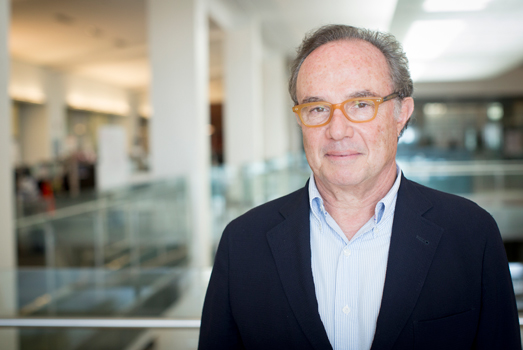Dean Magistretti awarded honorary CAPS membership

Professor Pierre Magistretti, Dean of KAUST's Biological and Environmental Science and Engineering Division, was awarded an honorary membership for the Chinese Association for Physiological Sciences (CAPS).
Prof. Pierre Magistretti, Dean of KAUST's Biological and Environmental Science and Engineering Division, was awarded an honorary membership from the Chinese Association for Physiological Sciences (CAPS) in October. CAPS is part of the China Association for Science and Technology, whose purpose is to promote scientific and technological progress, economic revitalization and social development of China.
"I was surprised when they honored me with the membership in Physiological Sciences. There is a long tradition in physiology in China, and outstanding research in neurophysiology is carried out in several universities such as Tsinghua, Beijing, Capital Medical and Fudan Universities, as well as in selected laboratories of the Chinese Academy of Sciences, in particular the Institute of Neuroscience in Shanghai," said Dean Magistretti. "When visiting these universities there, I was very impressed."
CAPS meets every three years (about 2000 participants) and to help establish international connections between Chinese physiology and physiology in the rest of the world, it awards a few honorary memberships to highly regarded physiologists outside of China. There have only been 15 honorary memberships awarded since the founding of the association in 1926, and this year three scientists received the honor.
In addition to Dean Magistretti, Prof. Denis Noble, a cardiovascular physiologist from Oxford who contributed to discovering how the heart regulates its excitability, and Prof. Tomas Hokfelt from Karolinksa Institute who is known for his research on neurotransmitters and neuropeptides, were honored.
Magistretti's field of research is brain energy metabolism and looking at the mechanisms that regulate the delivery of energy to active neurons. This has implications for functional brain imaging as all the existing techniques, that allow characterization of brain activity, only detect the use of energy by neurons.
"These techniques do not monitor directly neuronal activity, but they do monitor the energy consumption in many ways. What we have studied are the mechanisms that couple the activity of neurons to the use of energy," explained Magistretti. "In doing so, we discovered one of the roles of a particular type of brain cell called glia."

(left to right) Tomas Hokfelt of the Karolinska Institute, Dennis Noble, Oxford University, Pierre Magistretti, Dean of KAUST's Biological and Environmental Science and Engineering Division, Xiaomin Wang, President of CAPS and Vice-President of Capital Medical University, Beijing.
Magistretti says he believes he was honored for his work with glia cells. "Everyone knows neurons, but there is another population – the other half of the brain – which is glia cells. We showed that a type of these glia cells, known as astrocytes, can detect when neurons are active and import energy in the form of glucose, oxygen as well as increase blood flow in the activated area," he said.
Magistretti's interest in neuroscience began after he completed his medical school in Switzerland and was working on his Ph.D. in biology at the University of California at San Diego.
"As part of my PhD project, I started to work on the role of a new peptide, called Vasoactive Intestinal Peptide (VIP) which had just been discovered in the brain. I had the unconventional idea to study its effect on energy metabolism, because in peripheral tissues such as intestine or liver, where nerves containing it are also found, VIP had been shown to activate a signaling cascade that led to the mobilization of glycogen, the storage form of glucose" he said. "I found that VIP by acting on astrocytes, the only cells where glycogen is localized in the brain, was capable of delivering energy substrates to neurons. This initial experiment made me focus my research for the following years on the metabolic interactions between neurons and glia and their role in producing the signals that are detected by functional brain imaging and more recently in memory and neuroprotection."
At KAUST, Magistretti is expanding his research by utilizing the university's Visualization Laboratory to reconstruct in 3D the relationships between the blood vessels in the brain, the glia cells that surround them and the neurons. But this is just the beginning of where he sees his research going.
"I'm also looking forward to having an animal facility here at KAUST where we will be able to conduct experiments on rodents to further study the role of neuron-glia interactions in neuronal plasticity, memory and neuroprotection," he said.
Currently, his work is being conducted using cell lines. While these are interesting, they are removed from the actual physiological conditions. The animal facility will be a very significant addition to the University's resources for several research groups.
By Michelle Ponto, KAUST News

